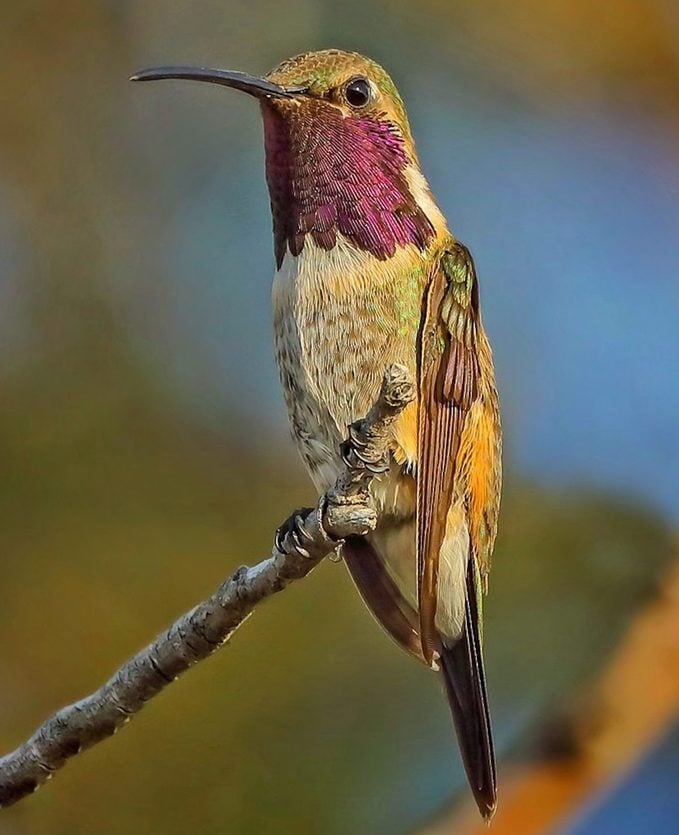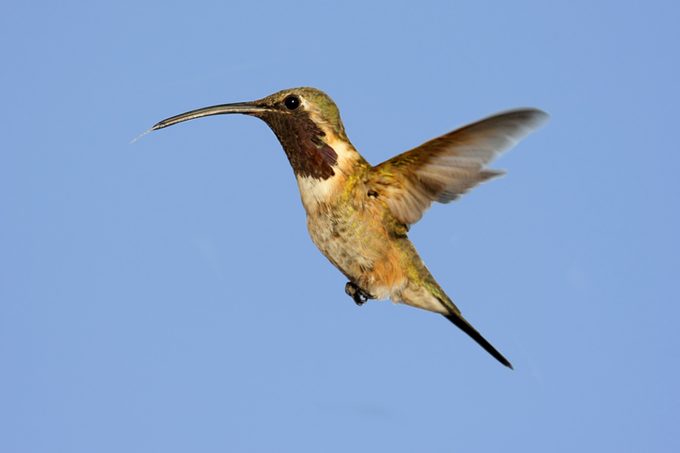How to Identify a Lucifer Hummingbird
Updated: Mar. 15, 2024
Get details about the bright colored lucifer hummingbird, including what males and females look like. Plus learn about their nests and range.
On This Page
What Does a Lucifer Hummingbird Look Like?

You might recognize a male lucifer hummingbird by its brightly colored purple gorget. Males are green-gray save for the gorget, rusty patches on the breast, and cream-colored feathers along the throat.
Females lack the vibrant gorget; instead, they have the same green-gray upperparts, buff or rusty underparts and a dark stripe by the eye. Both females and males have a curved bill.
Another good way to tell whether you’ve found a lucifer hummingbird is to make note of the bird’s environment. “Within their range, they’re pretty distinctive,” says Dr. Christopher J. Clark, hummingbird researcher and associate professor of Biology at the University of California – Riverside. “They’re this really classic Chihuahua desert hummingbird. In Texas and in Northern Mexico, in that kind of desert, they are the main hummingbird you will find in a really dry place with lots of cacti and not that close to water. The other hummingbird species that are around all like water more than they do.”
Meet the 15 types of hummingbirds found in the United States.
Lucifer Hummingbird Range
Unless you live in a very specific part of the United States, you’re not likely to find a lucifer hummingbird at your backyard sugar water feeder. “They have a small breeding range in the United States, and the main place where you’d find them is in Big Bend National Park,” Christopher says. “They are pretty much desert birds. There were reports of them showing up in Texas a few hundred miles outside of their normal range back when there was an intense drought, but that’s probably because they had so few flowers in their natural habitat that they were leaving their natural habitat to look for food sources.”
You might track one down in Arizona or other parts of Texas, but they’re generally considered a rare visitor. Christopher notes their range in southern Arizona and Big Bend National Park.
One Birds & Blooms reader spotted this bird in the Davis Mountains in Texas, well-known for being a hummingbird haven—annual hummingbird celebrations are even hosted there.

“This is a beautiful male lucifer hummingbird (above). The photo was taken high in the Davis Mountains in far west Texas. Every summer, thousands of hummingbirds call the Davis Mountains home. This was a lifer for me, meaning it was the first time I ever saw this bird. I look forward to returning in summer for, hopefully, more surprises,” says reader Randall Patterson.
Learn how to attract hummingbirds with 10 expert tips.
Lucifer Hummingbird Courtship and Nests
Christopher notes some unusual courtship and nesting practices in these hummingbirds which set them apart from other species.
“Females will often already have a nest and already have eggs, and the male will come up and do displays to the female while she’s already sitting on the nest,” he explains. “That’s confusing, because we think of courtship displays as the male trying to impress the female if she’s going to make a mating decision later. But she’s already made a mating decision. She already has a nest. It’s not entirely clear why they do this.”
He goes on to note that these birds build their nests in an unusual location: on prickly chollo cacti. This makes it easier to defend the nest from predators, but the lack of shade means female hummingbirds have to find other means of shading eggs from the sun.
“What will happen is when it’s hot and there’s direct sun on the nest, the female will stand on the side of the nest and hold her wings open to shade the eggs,” he says.
Sound and Calls
Bird songs courtesy of the Cornell Lab of Ornithology
How Did the Lucifer Hummingbird Get Its Name?

“Is a lucifer hummingbird named after the devil?” asks reader Mike Froio of Rome, New York.
Birding experts Kenn and Kimberly Kaufman explain, “At first glance it seems shocking. What did this little bird do to deserve such a name? But the British scientist William Swainson probably wasn’t thinking of the devil when he named this bird in 1827.
The name “lucifer” has had various meanings. For example, in ancient Rome it was the name given to Venus when that planet appeared in the morning sky—appropriately enough, since lucifer is based on Latin words meaning “light bearer” or “light bringer.”
Swainson probably chose the name after seeing how light reflected from the brilliant purple throat of the male lucifer hummingbird.
Next, meet the magnificent Rivoli’s hummingbird.
About the Experts
Kenn and Kimberly Kaufman are the official birding experts for Birds & Blooms. They are the creators of the Kaufman Field Guide series and they speak and lead birding tours all over the world.
Dr. Christopher J. Clark is a hummingbird researcher and associate professor of biology at the University of California – Riverside.




















